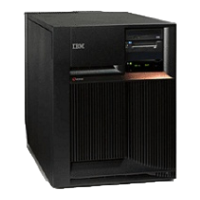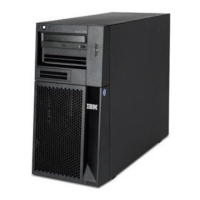Starting with the frame ID and HSL port location label for one end of an HSL cable, determine the frame
ID and port location label for the other end.
1. Sign on to SST or to DST if you have not already done so.
2. Select Start a Service Tool —> Hardware Service Manager —> Logical Hardware Resources —>
High Speed Link (HSL) Resources.
3. Move the cursor to the HSL loop that you want to examine, and select Resources associated with
loop—>Include non-reporting resources. The display that appears shows the loop resource and all
the ″HSL I/O Bridge″ and all the ″Remote HSL NIC″ resources connected to the loop.
4. Perform the following for each of the HSL I/O Bridge resources listed until you are directed to do
otherwise.
a. Move the cursor to the HSL I/O Bridge resource and select Associated packaging resource(s).
b. Compare the frame ID on the display with the frame ID (in hexadecimal format) that you are
looking to find (Ignore leading zeros).
Are the frame IDs the same?
v Yes: Continue with the next step.
v No: Select Cancel to return to the Logical Hardware Associated with HSL Loops display. Continue
with the next step, repeating it for each HSL I/O Bridge under the loop, until you are directed to do
otherwise.
5.
Perform the following:
a. Select Associated logical resource(s).
b. Move the cursor to the HSL I/O Bridge resource and select Display detail.
c. Examine the Leading port and Trailing port information. Search the display for the HSL port location
label that you recorded prior to starting this procedure. If the label is part of the information for the
Leading port, then select Follow leading port. If the label is part of the information for the Trailing
port, then select Follow trailing port.
d. Perform the step below that matches the function you selected in the previous step:
v If you selected Follow leading port, then examine the display for the Trailing port information.
Record, on the worksheet that you are using, the HSL port location label shown on the ″Trailing
port from previous resource″ line. Record this information as the ″To HSL Port Label″.
v If you selected Follow trailing port, then examine the display for the Leading port information.
Record, on the worksheet that you are using, the HSL port location label on the ″Leading port to
next resource″ line. Record this information as the″To HSL Port Label″.
e. Record the ″Link type″ (Copper or Optical) on the worksheet that you are using in the field
describing the cable type.
f. Record the resource name on the display.
g. Select Cancel —> Cancel —> Cancel to return to the Logical Hardware Associated With HSL
Loops″ display.
h. Move the cursor to the resource with the resource name you recorded in step 5f (See page 89).
i. Select Associated packaging resource(s).
j. Record the frame ID on the worksheet that you are using for the ″To Frame ID″.
k. Return to the procedure that sent you here.
This ends the procedure.
Bus
PIP IOP-01, IOP reset: For use by authorized service providers.
Use this procedure to reset an IOP.
Attention: When the IOP reset is performed, all resources controlled by the IOP will be reset. Perform the
IOP reset only if the customer has verified that the IOP reset can be performed at this time.
Analyze hardware problems 89
